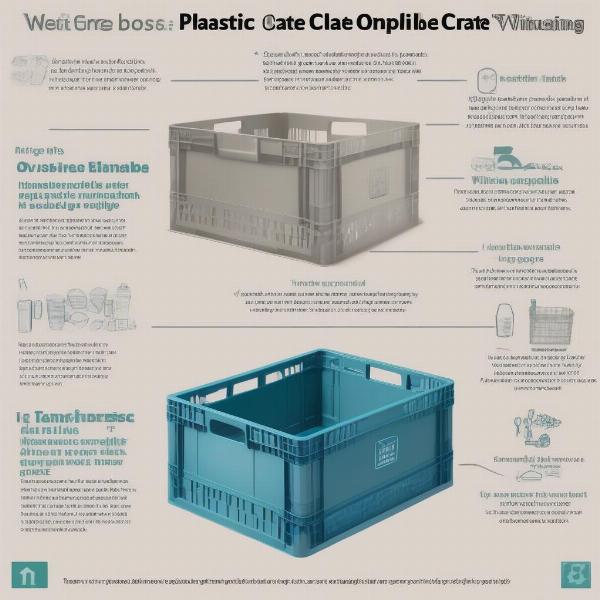Plastic dog crates are a popular choice for pet owners due to their durability, portability, and ease of cleaning. Whether you’re house training a puppy, providing a safe space for your adult dog, or traveling with your furry friend, selecting the right plastic dog crate is crucial for their comfort and well-being. This guide will walk you through everything you need to know about choosing the perfect plastic dog crate for your canine companion.
Understanding the Benefits of a Plastic Dog Crate
Plastic crates offer several advantages over other types of crates. They are lightweight, making them easy to move around your home or transport in a vehicle. The plastic material is also easy to clean and disinfect, which is essential for maintaining hygiene and preventing the spread of germs. Furthermore, many plastic crates are designed with ventilation holes to ensure proper airflow, keeping your dog comfortable even in warmer temperatures.
Sizing Your Plastic Dog Crate
Choosing the right size crate is paramount. Your dog should be able to stand up, turn around, and lie down comfortably inside the crate. A crate that is too small will restrict their movement and cause discomfort, while a crate that is too large can defeat the purpose of house training. Measure your dog’s height and length, adding a few inches to each measurement to determine the appropriate crate size.
Factors to Consider When Choosing a Plastic Dog Crate
Besides size, several other factors should be considered when choosing a plastic dog crate. Durability is key, especially for chewers or anxious dogs. Look for crates made from heavy-duty, non-toxic plastic. Ventilation is also crucial for your dog’s comfort and safety. Ensure the crate has ample ventilation holes on all sides. Portability features like handles and wheels can be beneficial if you plan to travel with your dog. Finally, consider the ease of assembly and cleaning. Some crates are easier to assemble and disassemble than others, which can be a significant advantage.
 Factors to consider when choosing a plastic crate for your dog
Factors to consider when choosing a plastic crate for your dog
Introducing Your Dog to Their New Crate
Introducing your dog to their new crate should be a gradual and positive process. Start by placing the crate in a familiar area of your home and leaving the door open. Encourage your dog to explore the crate by placing treats and toys inside. Never force your dog into the crate. Once they are comfortable entering and exiting the crate on their own, you can start closing the door for short periods, gradually increasing the duration.
Common Mistakes to Avoid
Avoid using the crate as a punishment. The crate should be a safe and positive space for your dog. Don’t leave your dog in the crate for extended periods, especially puppies. Ensure they have regular breaks for potty and exercise. Finally, don’t choose a crate based solely on price. Investing in a quality crate will benefit both you and your dog in the long run.
Conclusion
A plastic dog crate can be a valuable tool for pet owners, providing a safe, secure, and comfortable space for their canine companions. By considering the factors outlined in this guide, you can choose the perfect plastic dog crate to meet your dog’s individual needs and enhance their overall well-being. Remember to prioritize size, durability, ventilation, and ease of cleaning when making your decision.
FAQ
- How do I clean a plastic dog crate? Plastic crates can be easily cleaned with soap and water. For tougher stains, you can use a pet-safe disinfectant.
- Can I use a plastic dog crate for air travel? Yes, most airlines allow plastic dog crates for air travel, but it’s essential to check with the specific airline for their regulations.
- What should I do if my dog chews on their plastic crate? If your dog chews on their crate, you can try using a chew deterrent spray or providing them with alternative chew toys.
- Are plastic dog crates suitable for all breeds? Plastic dog crates are suitable for most breeds, but certain breeds, particularly those with brachycephalic (short-nosed) features, may require crates with enhanced ventilation.
- How long can I leave my dog in a plastic crate? Adult dogs can generally tolerate being in a crate for up to 8 hours, but puppies should not be left in a crate for more than a few hours at a time.
- Can I use a plastic dog crate for house training? Yes, plastic dog crates are commonly used for house training as they can help establish a routine and prevent accidents.
- What accessories should I put in a plastic dog crate? A comfortable bed, food and water bowls, and a few toys are essential accessories for a plastic dog crate.
ILM Dog is a leading online resource for dog owners worldwide, offering expert advice and practical tips on all aspects of dog care, including breed selection, health and medical care, training and behavior, nutrition, grooming, exercise, and accessories. We are committed to providing reliable information to help dog owners make informed decisions and provide the best possible care for their canine companions. For personalized advice or to explore our wide range of dog products and accessories, contact us at [email protected] or +44 20-3965-8624. Visit ILM Dog for more helpful resources and expert guidance.